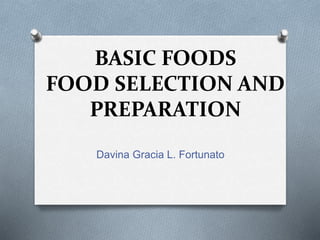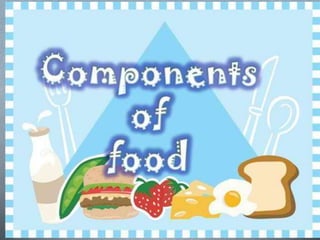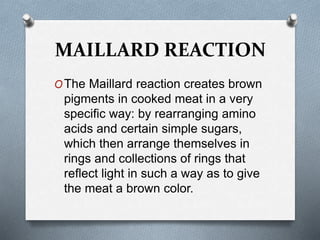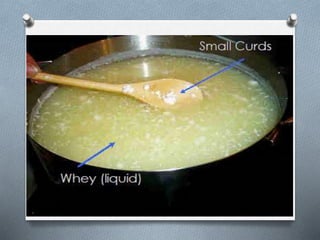Basic foods
- 1. BASIC FOODS FOOD SELECTION AND PREPARATION Davina Gracia L. Fortunato
- 2. FOOD OPhysiological: Any substance which when taken into the body provides energy, build and repairs tissues and regulates body processes. OBiological: Any substance which when eaten sustains life and nourishes the body.
- 3. OFoods are derived from plants and animals, both terrestrial and aquatic. OFood materials follow a development process as illustrated by the changes that a fruit undergoes before it can be used as food.
- 9. MAILLARD REACTION OThe Maillard reaction creates brown pigments in cooked meat in a very specific way: by rearranging amino acids and certain simple sugars, which then arrange themselves in rings and collections of rings that reflect light in such a way as to give the meat a brown color.
- 11. OThe purpose of an enzyme in a cell is to allow the cell to carry out chemical reactions very quickly. These reactions allow the cell to build things or take things apart as needed. This is how a cell grows and reproduces. ENZYMATIC BROWNING
- 12. ENZYMATIC BROWNING OEnzymatic browning reaction needs oxygen either from the air or from intercellular spaces within the tissue.
- 13. Obananas turn brown because a hormone within them triggers the release of ethylene gas (C2H4). This accelerates the ripening processes until the banana becomes over-ripe. OEthylene has an accomplice called polyphenol oxidase (or PPO for short). ItĄŊs found in apples and potatoes, so leaving your banana next to an apple will hasten the ripening process.
- 15. OIs a reaction that takes place when oxygen has access to products containing fat or pigments.
- 16. OIf fats oxidize, they produce Ą°offĄą odors and flavors OIf pigments oxidize, they can change color completely
- 17. HYDROLYSIS OF PROTEINS AND POLYSACCHARIDES
- 18. OProtease is a general term for enzymes that breakdown proteins. When a protease breaks down a protein, the texture of the food is altered because the protein will lose its ability to bind water.
- 19. OProteases refers to a group of enzymes whose catalytic function is to hydrolyze (breakdown) proteins
- 20. O Proteins are made up of lots of amino acids joined together by peptide bonds. O Hydrolysis of the protein is what happens when the peptide bonds are broken. O lysis = splitting; hydro = water O The result of hydrolysis is smaller amino acid chains (peptides), and free amino acids. O The solution containing the protein pieced (small peptide chains and free amino acids) is called a hydrolysate solution.
- 22. OPolysaccharides such as starch, cellulose, and pectins are also prone to hydrolysis with resulting loss in texturing ability. Starch will lose its gelling properties when hydrolyzed.
- 23. O http://www.scienceweek.ie/chemistry-of- cooking.html O http://www.britannica.com O DE LEON, S.Y. et al. 1999. Basic Foods for Filipinos 3rd Edition. Merriam and Webster Inc., Metro Manila, Philippines.






















